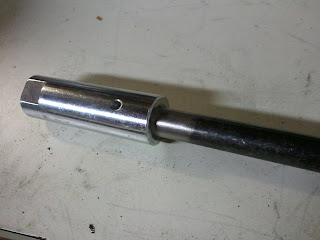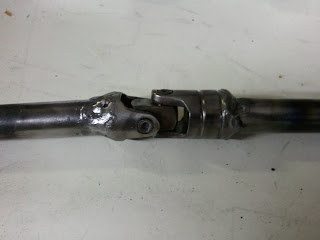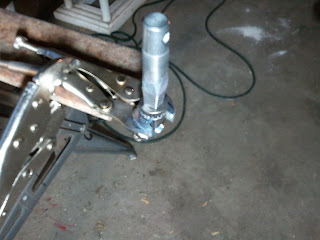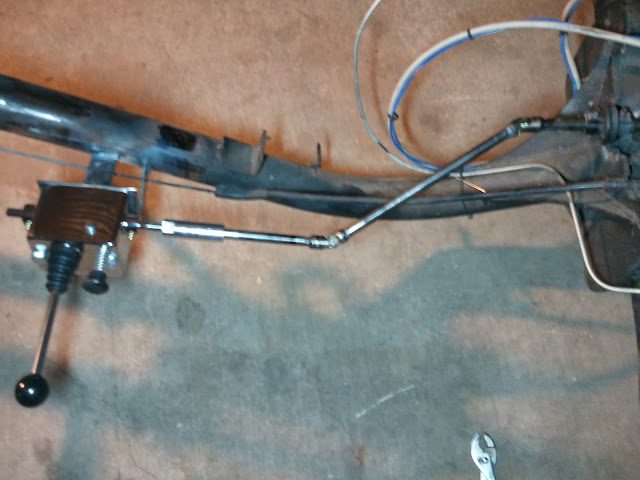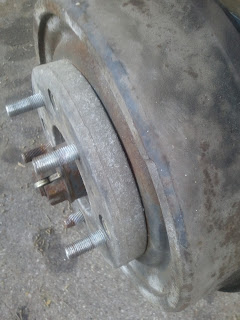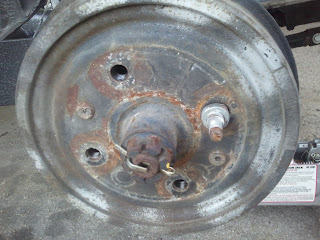I apologize in advance for not taking many pictures of the work on the white trike. We were kinda rushing to get it on the road so Gabby could take it to our BTW local chapter meeting on Sunday.
The white trike was pretty much in ready-to-inspect condition, other than a silent horn.
Friday after work, I made a couple of stops and got some things I would need to put an obnoxiously loud horn on it.
The existing horn did have power to it, but not even a peep would emanate. I ran a wire from the old horn to a relay in the engine compartment. I mounted the horn by the battery and connected it to the battery, through the relay and a fuse. Of course, the positive battery terminal was corroded, making it difficult to connect to and the rubber battery tie down crumbled in my hands, so I went to the ubiquitous Autozone. I replaced the battery terminals, which involved cutting the charging lead from the generator since it’s bolt on the old battery terminal was inaccessible without a time machine. When I went to put a new connector on the charging lead, the corrosion had leached up the line, preventing it from taking solder. I elected to replace the wire, which was a good idea because it turned out to have a splice in it.
All that is fixed up and man, that thing is loud
For following is the very short version because it’s 2:30AM and I am having trouble forming complete.
See, I told you… I am editing this early Sunday evening, and I’m leaving the previous line there because that’s exactly how I wrote it at 2:30AM.
Saturday, we went shopping for parts, most notably a vacuum advance distributor to banish the famous flat spot. We did a little more parts shopping and went home. The inspection of the trike went without issue, then we started into the stuff we’d bought for it.
I forgot to take pictures for most of it… :/
I did take a picture of the first post-purchase bling to go on, a fuel pump blanking plate.
You might expect most anything *except* a fuel pump blanking plate installation story to include a bit of excitement. pshaw…
The trike runs with an electric fuel pump, and flushed with the relative success of my previous fuel pump blanking plate installation, I was keen to get on with it.
In the back of my mind, I think I noticed that the existing mechanical fuel pump looked kind of new and the previous owner reported that they had installed an electric fuel pump. When I tried to put in my blanking plate, I discovered why.
An aircooled VW engine fuel pump is operated by a pushrod that is rides an eccentric on the distributor drive shaft. Older, generator equipped engines use a pushrod that is about 4.5 inches long. Less old (factory) alternator equipped engines used a shorter fuel pump to clear the larger alternator, and thus had a shorter 4 inch pushrod. The smaller pump will work on either engine, so long as you have the shorter push rod. From the various auto parts stores, the smaller pump is just about universally stocked, but ya gotta use that shorter pushrod. This engine had the longer pushrod.
I’m sure the first time the installer cranked the engine, it was either very exciting or all they knew is that the engine still didn’t run.
For my part, it took a lot of pulling and tugging and twisting to get the bent rod out. Then the plastic heat insulator thing was broken. There is a piece of it still firmly attached at the bottom of the hole, though now it is nicely covered with a shiny new blanking plate.
Installed the distributor.
Just setting the basic timing might have gone a long way with the old one, but it runs WAY better now. Incidentally, the old distributor had a Pertronix electronic ignition module in it. I toyed with moving it to the new distributor and I am still interested in doing that, though I want to make sure I can just pull the sensor disk off.
I did *not* install new pulleys because the generator pulley was pretty well stuck and it looks like the crankshaft pulley is there to stay, too, since someone freakin’ welded it on….
In case you’re wondering, ya don’t do that. And, just in case you somehow think you need to… say, you live in a post apocolyptic desert and maybe large bolts are scarce…. a couple of tacks or stitches would be more than enough to hold the pulley on until the horn sounds… You don’t need a continuous bead.
Sadly, my heroic efforts to remove the pulley before I discovered this little tidbit bent the pulley. I again owe a debt of gratitude to the inventor of the deadblow hammer. May his lead shot ever flow.
There was a long list of things done to it Saturday evening, such as adjusting the seat, changing out the shifter (one of three steps needed to make it shift nicely), cleaning the air filter (think I saw Cuban Holy pollen in there), quick and dirty painting of the bonked fender, screws and TyWraps to minimize rattling, lots and lots of polishing, cleaning, buffing and namecalling.
After staying up so late Saturday night, we got up early Sunday morning and moved the brake and clutch pedals off the kind of strange pods they were mounted on. Time did not allow me to reroute the foot throttle cable, so the one for the brake is still physically there, but that will go soon.
The trike made it to the meeting without incident and was well received and Gabby took it on to work. I am about to go meet her for the ride home…




















